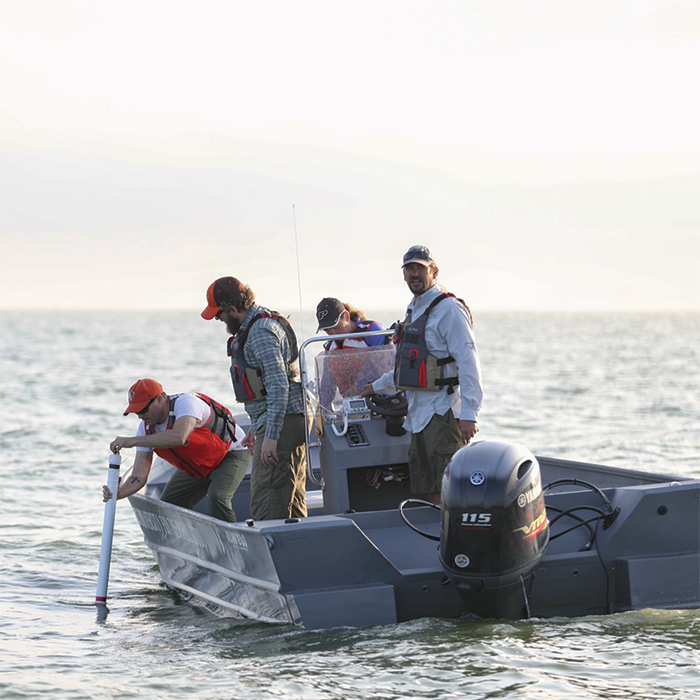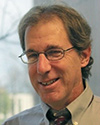Partnerships for Environmental Public Health (PEPH)

Community Science Aids Harmful Algal Blooms Research
July 13, 2022
Interviewee: George Bullerjahn, Ph.D.
In this episode, we’ll hear from George Bullerjahn, Ph.D., who directs the Great Lakes Center for Fresh Waters and Human Health. Bullerjahn discusses a community science program that engages charter boat captains and U.S. Coast Guard personnel to collect water samples and other data on Lake Erie. This information provides center researchers with the robust data they need to monitor, predict, and mitigate harmful algal blooms (HABs). Through this community science effort, the center also increases public awareness of HABs and how local communities can help keep Lake Erie healthy.
(Photo: Center researchers and charter boat captains collect water samples on Lake Erie. Photo courtesy of Bullerjahn.)
Community Science Aids Harmful Algal Blooms Research
Algae are essential components of aquatic ecosystems. But too much of a good thing can be toxic. Harmful algal blooms, or HABs, occur when algae grow out of control and produce toxins that can kill fish and other aquatic animals. HAB toxins can also harm human health, causing effects from gastrointestinal illness and liver damage to dementia and even death. By understanding the factors that cause HABs, such as excess nutrients in water and warmer water temperatures, scientists can better predict when these blooms may occur. This can provide state and local officials advance warning to slow the spread blooms and minimize human health risks.
In this episode, we’ll hear from George Bullerjahn, Ph.D., who directs the Great Lakes Center for Fresh Waters and Human Health. Bullerjahn discusses a community science program that engages charter boat captains and U.S. Coast Guard personnel to collect water samples and other data on Lake Erie. This information provides center researchers with the real-time data they need to monitor and predict HABs. Through this community science effort, the center also increases public awareness of HABs and how local communities can help keep Lake Erie healthy.
Interviewee:

George Bullerjahn, Ph.D., is an emeritus professor of biological sciences at Bowling Green State University. He also directs the Great Lakes Center for Fresh Waters and Human Health, which is co-funded by NIEHS and the National Science Foundation. At the center, Bullerjahn’s research focuses on cyanobacterial HABs, which can produce toxins that harm human health. He works to identify how factors in aquatic systems, such as changes in nitrogen availability, influence HAB toxicity. He also examines how climate change and nutrients may affect bloom growth.
Center outreach efforts aim to improve community awareness of the health risks of exposure to HAB toxins and the factors driving their growth. Through a community science project, Bullerjahn and collaborators trained charter boat captains and U.S. Coast Guard personnel to collect water samples and other data that will help scientists track and predict algal blooms in Lake Erie.
Resources:
- Check out slides from a 2020 PEPH webinar featuring Bullerjahn in which speakers discussed community science efforts within the Centers for Oceans and Human Health program.
- Learn more about harmful algal blooms from NIEHS and the National Oceanic and Atmospheric Administration.
References:
- Carson MA, Doberneck DM, Hart Z, Kelsey H, Pierce JY, Porter DE, Richlen ML, Schandera L, Triezenberg HA. 2022. A strategic framework for community engagement in oceans and human health. Comm Sci; doi: 10.1029/2022CSJ000001. [Full Text Carson MA, Doberneck DM, Hart Z, Kelsey H, Pierce JY, Porter DE, Richlen ML, Schandera L, Triezenberg HA. 2022. A strategic framework for community engagement in oceans and human health. Comm Sci; doi: 10.1029/2022CSJ000001.]
- Bullerjahn GS, McKay RM, Davis TW, Baker DB, Boyer GL, D'Anglada LV, Doucette GJ, Ho JC, Irwin EG, Kling CL, Kudela RM, Kurmayer R, Michalak AM, Ortiz JD, Otten TG, Paerl HW, Qin B, Sohngen BL, Stumpf RP, Visser PM, Wilhelm SW. 2016. Global solutions to regional problems: Collecting global expertise to address the problem of harmful cyanobacterial blooms. A Lake Erie case study. Harmful Algae 54:223-238. [Full Text Bullerjahn GS, McKay RM, Davis TW, Baker DB, Boyer GL, D'Anglada LV, Doucette GJ, Ho JC, Irwin EG, Kling CL, Kudela RM, Kurmayer R, Michalak AM, Ortiz JD, Otten TG, Paerl HW, Qin B, Sohngen BL, Stumpf RP, Visser PM, Wilhelm SW. 2016. Global solutions to regional problems: Collecting global expertise to address the problem of harmful cyanobacterial blooms. A Lake Erie case study. Harmful Algae 54:223-238.]


